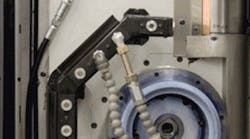For gears to work most effectively and efficiently, their mating surfaces must finely mesh — a trait often bestowed with heavy-duty and precise gear-grinding equipment. Gleason Corp. of Rochester, N.Y. — an early pioneer in the development of bevel gears used in vehicle differentials — today builds state-of-the-art gear-grinding machines that enable high-quality gear production.
Positional accuracy is critical
Key to achieving this quality level is ensuring that workpieces are well lubricated and do not overheat during the grinding process. When Gleason discovered that it needed a replacement actuator to position a heavy coolant head on one of its gear-grinding machines, the company's engineers had to explore several options — due to stringent torque requirements and space constraints — before arriving at a workable solution.
“The Phoenix II 275G gear-grinding machine is designed to create a fine finish on the mating surfaces of bevel gears that have already been rough cut,” explains design engineer George Chamberlain. “Once the mating surfaces are properly ground, gears are interchangeable in gearing systems and run efficiently and quietly. Grinding is becoming the preferred bevel gear finishing method, as opposed to the traditional gear lapping process, in which mating gears are lapped together with an abrasive slurry to create a matched pair.”
Powerful and compact actuator required
Lubricating coolant must be precisely directed at the grinding wheel's point of contact with the gear at all times. “Positional accuracy of the coolant heads is necessary because the point of contact must be flooded with coolant, so the part isn't burned,” says Chamberlain. “Coolant also lubricates and flushes away grinding debris created by the process.”
In the machine's original design, an electric actuator moved a 50-lb manifold of coolant jets in small increments as the grinding wheel was consumed and changed dimensions. However, the original motor and actuator sometimes lacked the necessary torque to move the heavy coolant manifold. Worse yet, when the actuator became overloaded due to increased system friction, it would stop and sometimes lose its position.
Modifications necessary
“This would cause the machine to send a message prompting the operator to investigate the situation before the next cycle began,” Chamberlain explains. “The machine would indicate a positional error, and the operator would then need to re-reference the coolant's position.” The result? Reduced productivity and increased downtime for some of Gleason's end users.
Sealed actuator
One idea was to replace the original actuator's stepper motor with a more powerful servomotor. However, the particular actuator Gleason was using would not allow such a replacement. What's more, limited space within the machine's grinding chamber would not accommodate a larger motor. For these reasons, Chamberlain consulted with Brian Mulholland of Hughes Hi-Tech in Clarence, N.Y., a power transmission distributor, and learned that actuators from Tolomatic Inc., Hamel, Minn., could accept a more powerful servomotor. In addition, Chamberlain found that the Tolomatic RSM rod-style screw actuator was not only powerful enough for the application, but also extremely compact.
Optional motor mounts
Most rod-style actuators have a screw that is driven by a motor connected inline. In contrast, RSM actuators feature a reverse-parallel motor drive: The motor is mounted alongside the actuator and drives the screw through a toothed belt-and-pulley assembly. With thrust capability from 70 to 7,000 lb, even the smallest 12-in. model had enough power for Gleason's application.
Secondary lead screw bearing
While the RSM rod-style actuator is an off-the-shelf product for Tolomatic, the company's engineers often design and modify standard products in-house. In Gleason's case, a number of modifications were made to the RSM actuator:
Custom front flange
Mating surfaces of the motor mount, drive belt housing, and inspection lid were fully gasketed to prevent spraying coolant from getting into the actuator.
Additional sensor
The actuator was supplied with two motor mounting flanges to accommodate different brands of servomotors. This gave Gleason the flexibility to match either a Fanuc or Moog servomotor to the production demands of its end users.
The end of the actuator was fitted with a secondary support bearing to accommodate high radial loads due to drive belt tensioning.
The end of the rod was fitted with a custom mounting flange to mate with Gleason's coolant head assembly, allowing drop-in compatibility during manufacture or in the field.
Video: Novel flange perfects auto body buffing
In the unlikely event of a broken drive belt, Gleason wanted the machine to have a feedback loop to avoid process issues associated with a mispositioned coolant head. A toothed rotor installed at the end of the screw with a Balluff sensor mounted on it solved this issue; the sensor reports the screw's position within 0.1 mm and signals the machine if a belt failure occurs.
Gleason manufactures several Phoenix II 275G gear-grinding machines every year, and has received zero reports of coolant system or machine fault issues since incorporating the RSM actuator into the machine design.
For more information, contact Tolomatic Inc. • (800) 328-2174 • tolomatic.com
The buffing of contoured surfaces — for example, the mighty curves of high-end sports cars — is a complex task. Here, robotic arms must maintain constant force over an ever-changing physical landscape. A new flange from KEBA Corp., Troy, Mich., greatly simplifies this process and is highlighted in a video posted on the motionsystemdesign.com/video page.
The KEBA Active Contact Flange greatly simplifies robotic path programming, because the flange independently and automatically compensates for positioning to maintain a constant force on the work surface. Among other things, this allows for a straight line (linear move) to be employed in the robot program while buffing a curved object such as an auto body. Users simply set the required force and the flange takes care of the rest.
